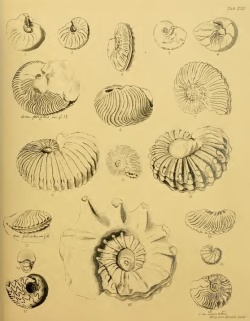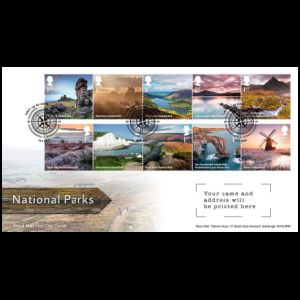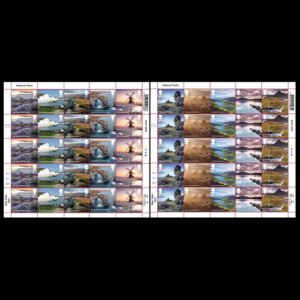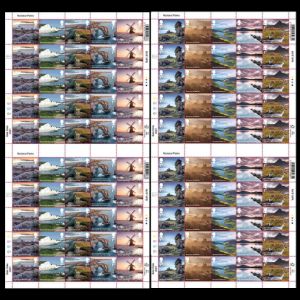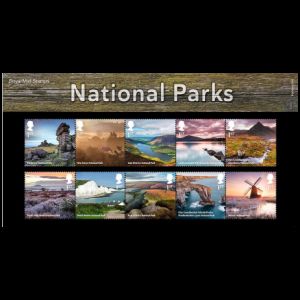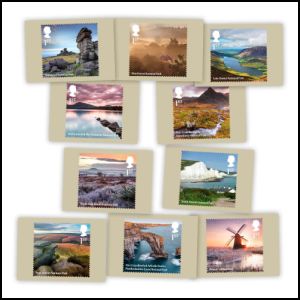UK 2021 "National Parks"
| << previous | back to index | next >> |
| Issue Date | 14.01.2021 |
| ID | Michel: Scott: UPU: Category: Ot |
| Design | Studio Mean |
| Stamps in set | 10 |
| Value | 1st class stamps:
Dartmoor National Park New Forest National Park Lake District National Park Loch Lomond and the Trossachs National Park Snowdonia National Park Parc Cenedlaethol Eryri North York Moors National Park South Downs National Park Peak District National Park Pembrokeshire Coast National Park Parc Cenedlaethol Arfordir Penfro Broads National Park |
| Size (width x height) | 36.5mm x 34.7mm |
| Layout | Two Mini-Sheets of 25 and two Mini-sheets of 50 stamps |
| Products | FDCx1, MSx4, PPx1, PCx10 |
| Paper | |
| Perforation | |
| Print Technique | Lithography |
| Printed by | International Security Printers |
| Quantity | |
| Issuing Authority | Royal Mail |
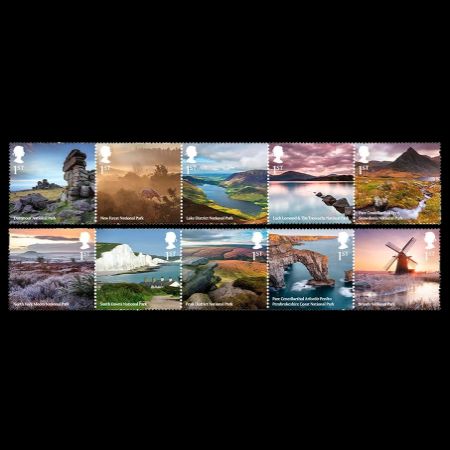
The set of 10 stamps, printed in two horizontal se-tenant strips, with images selected in collaboration with the National Parks, commemorates the 70th anniversary of the opening of the first of the UK’s 15 National Parks.
National Parks make up 10 percent of England, Scotland and Wales and were created to open up the countryside to ‘ordinary people’.
The National Parks and Access to the Countryside Act was passed in 1949.
The Lake District, Peak District, Dartmoor and Snowdonia national parks were created two years later.
These 1st class stamps shows landscapes of the following National Parks: the Peak District, Snowdonia, Dartmoor, North York Moors, The Broads, New Forest, The Lake District, South Downs, Pembrokeshire Coast and Loch Lomond and The Trossachs.
Some of this parks are also great places for fossil hunters.
South Downs
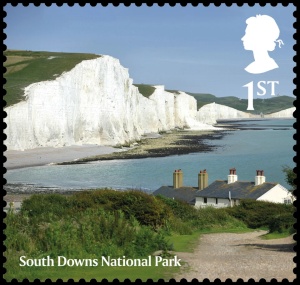 The South Downs National Park forms a large area that includes the chalk range of the South Downs and large parts of the Weald.
The South Downs National Park forms a large area that includes the chalk range of the South Downs and large parts of the Weald.
The South Downs are a range of chalk hills that extends for about 670 km2 across the south-eastern
coastal counties of England from the Itchen Valley of Hampshire in the west to Beachy Head, in the Eastbourne Downland
Estate, East Sussex, in the east.
The South Downs are characterised by rolling chalk downland with close-cropped turf and dry valleys, and are recognised
as one of the most important chalk landscapes in England.
The range is one of the four main areas of chalk downland in southern England.
The rock is composed of the microscopic skeletons of plankton which lived in the sea, hence its colour. The chalk has many fossils, and bands of flint occur throughout the formation. The Chalk is divided into the Lower, Middle and Upper Chalk, a thin band of cream-coloured nodular chalk known as the Melbourn Rock marking the boundary between the Lower and Middle units.
Fossils of marine prehistoric animals such as ammonites, echinoids and molluscs can be found at coastline at the foot of the South Downs National Park.
One of the most famous English paleontologists of the XIX century, Gideon Mantell (1790-1852) made some research at the region, then published his results in a book "The fossils of the South Downs : or, Illustrations of the geology of Sussex", printed in London in 1822 and contains several nice illustration of the marine fossils, made by Mary Ann Mantell.
Mary Ann Mantell (1795–1869) was a wife of Gideon Mantel.
She is credited with the discovery of the first fossils of the dinosaur Iguanodon. Mary Ann Mantell drew up 364 fine lithographs of the fossils, that were then used in her husband's scientific publication "The Fossils of the South Downs" and in "Illustrations of the Geology of Sussex" published in 1827, in which Gideon Mantell describes the Iguanodon.
References
- [R1] Stamps release: Royal Mail, BBC, The SUN
- [R2] South Downs: Wikipedia, southdowns.gov.uk,
- [R3] Gideon Mantell:
Wikipedia,
The book "The fossils of the South Downs : or, Illustrations of the geology of Sussex": biodiversitylibrary.org, - [R4] Mary Ann Mantell: Wikipedia,
- [R5] the Peak District National Park: peakdistrictinformation.com, thepeakdistrict.info,
Acknowledgements
Many thanks to- Dr. Peter Voice from Department of Geological and Environmental Sciences, Western Michigan University, for reviewing the draft page and his very valuable comments.
| << previous | back to index | next >> |
